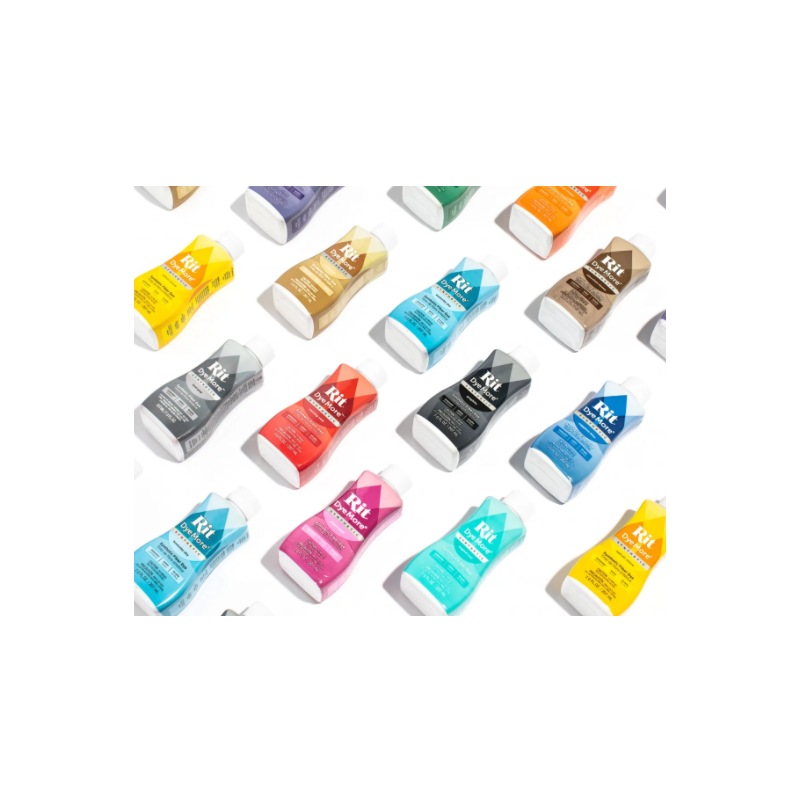




With so many diverse synthetic fabric iterations on the market, we thought it was high time to offer a dye capable of taking those very fabrics to the next level. That’s why we’re proud to introduce Rit DyeMore, a dye specially made for synthetic fabrics like polyester, polyester cotton blends, acrylic, and acetate. And like our All-Purpose formula, DyeMore is non-toxic and perfect for use in the home.
No matter what you plan to dye, whether it’s a pair of jeans or set of curtains, the first step is to choose the right dye for your fabric or material. Always check the care label for the fiber content of the item you plan to dye. This dye is for synthetic fibers, which include polyester, acrylic, acetate and nylon. If you have a blended garment that contains more than 35% synthetic fibers, this is the dye you will need to use. If you are dyeing a garment with less than 35% synthetic fibers, use Rit All-Purpose Dye instead.
HOWTO
Due to the complexity of dyeing synthetics, you must use the stovetop method to maintain an almost boiling temperature for the duration of your dyeing (93°C or greater). Accordingly: (1) you cannot dye anything that won’t fit into a pot on your stove and (2) you cannot use your washer because the machine won’t be able to achieve the water temperature needed for Rit DyeMore to penetrate the fabric.
Color
If the garment you are dyeing is white or off white, then you should be able to achieve true color. However, if your garment has an existing color, then your only option is to overdye it with a darker color.
1. To determine how much dye is needed, weigh the item to be dyed on a food scale or estimate the weight. As a general guideline, one bottle of Rit DyeMore will dye up to two pounds of dry fabric. If dyeing 100% polyester or trying to achieve a very bolder color, double the dye quantity.
2. Fiber content and weight affect how color appears. If you are in doubt as to whether your fabric will accept dye or achieve the color you want, we recommend testing a swatch first.
3. Before dyeing, remove any visible stains on the garment. This will help achieve uniform color results when dyeing. Pre-wash item in warm, soapy water without any fabric softener. This helps to remove any finishes that may interfere with dye absorption.
4. Cover work area around stove with plastic table cover or newspaper and have paper towels handy to protect against any possible spills.
5. Wear rubber gloves to protect hands from getting stained and to insulate them when working with hot water.
6. Due to the complexity of dyeing synthetics, you must use the stovetop method to maintain an almost boiling temperature for the duration of your dyeing (200ºF / 93ºC or greater).
7. Fill a stainless steel pot with enough water for the fabric to move freely. We recommend using three gallons of water for every pound of fabric.
8. Add 1 teaspoon / 5 mL of dish detergent to help promote level dyeing.
9. Cover pot and heat water on stove top to just below boiling (200ºF / 93ºC or greater).
10. When water begins to simmer, add well-shaken dye and mix well.
11. Wet the item you are going to be dyeing and add it to the dyebath.
12. Keep temperature at a low simmer for the duration of your dyeing.
13. Stir slowly and continuously. The first 10 minutes are the most critical. Stirring helps to ensure an even color with no splotches.
14. Item can remain in dyebath from 10 minutes up to one hour. If dyeing polyester or a polyester cotton blend, keep the fabric in the dyebath for at least 30 minutes to ensure that the color takes fully. Nylon tends to dye very quickly and much darker than other fibers so the actual time needed in the dyebath is less.
15. When desired color is achieved, remove from dyebath. Fabric will look darker when wet and will dry lighter. Squeeze out excess dye.
16. If dyeing a blend containing cotton, linen, rayon or ramie, use Rit ColorStay Dye Fixative immediately after dyeing and before washing to enhance the color and reduce color bleeding.
17. Rinse in warm water and then gradually cool water until rinse water begins to run clear.
18. Wash in warm water with a mild detergent, rinse and dry.
You might also like